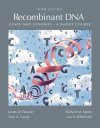About this book
Recombinant DNA, Third Edition, is an essential text for undergraduate, graduate, and professional courses in Genomics, Cell and Molecular Biology, Recombinant DNA, Genetic Engineering, Human Genetics, Biotechnology, and Bioinformatics.
The Third Edition of this landmark text offers an authoritative, accessible, and engaging introduction to modern, genome-centered biology from its foremost practitioners. The new edition explores core concepts in molecular biology in a contemporary inquiry-based context, building its coverage around the most relevant and exciting examples of current research and landmark experiments that redefined our understanding of DNA. As a result, students learn how working scientists make real high-impact discoveries.
The first chapters provide an introduction to the fundamental concepts of genetics and genomics, an inside look at the Human Genome Project, bioinformatic and experimental techniques for large-scale genomic studies, and a survey of epigenetics and RNA interference. The final chapters cover the quest to identify disease-causing genes, the genetic basis of cancer, and DNA fingerprinting and forensics. In these chapters the authors provide examples of practical applications in human medicine, and discuss the future of human genetics and genomics projects.
Contents
FOUNDATIONS OF DNA
1. DNA Is the Primary Genetic Material
2. Information Flow from DNA to Protein
3. Control of Gene Expression
4. Basic Tools of Recombinant DNA
5. Fundamental Features of Eukaryotic Genes
6. A New Toolbox for Recombinant DNA
7. Mobile DNA Sequences in the Genome
8. Epigenetic Modifications of the Genome
9. RNA Interference Regulates the Genome
FOUNDATIONS OF GENOMICS
10. Fundamentals of Whole-Genome Sequencing
11. How the Human Genome was Sequenced
ANALYZING GENOMES
12. Comparing and Analyzing Genomes
13. From Genome Sequence to Gene Function
HUMAN GENOMICS
14. Finding Human Disease Genes
15. Understanding the Genetic Basis of Cancer
16. DNA Fingerprinting and Forensics
Customer Reviews
Biography
James D. Watson is the Chancellor of Cold Spring Harbor Laboratory, USA, and was awarded the Nobel Prize (1962) for his discoveries concerning the molecular structure of nucleic acids.
Amy A. Caudy is a Lewis-Steiger Fellow, at the Lewis-Steiger Institute for Integrative Genomics at Princeton University, USA. Combining methods from genomics, and biochemistry, her research seeks to understand the regulation of mitochondrial replication and abundance.
Richard M. Myers is the Stanford W. Ascherman Professor and Chairman of the Department of Genetics at Stanford University, USA. He studies the structure, function and evolution of the human genome to understand roles that genes play in human diseases such as Huntington disease, Parkinson disease, hypertension, insulin resistance, and atherosclerosis.
Jan A. Witkowski is the Executive Director of the Banbury Center, USA, the Editor-in-chief of Trends in Biochemical Sciences and a professor at the Watson School of Biological Sciences. Prior to his role at Cold Spring Harbor, he ran a research lab focused on the DNA-based diagnosis of human genetic diseases.






































